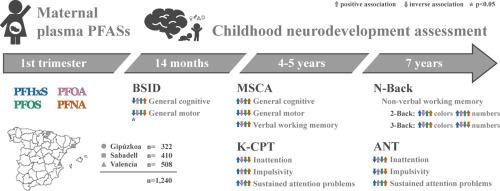Journal of Hazardous Materials ( IF 13.6 ) Pub Date : 2021-01-20 , DOI: 10.1016/j.jhazmat.2021.125185 Christian Carrizosa 1 , Mario Murcia 2 , Virginia Ballesteros 3 , Olga Costa 1 , Cyntia B Manzano-Salgado 4 , Jesus Ibarluzea 5 , Carmen Iñiguez 6 , Maribel Casas 4 , Ainara Andiarena 7 , Sabrina Llop 8 , Aitana Lertxundi 9 , Thomas Schettgen 10 , Jordi Sunyer 4 , Ferran Ballester 11 , Martine Vrijheid 4 , Maria-Jose Lopez-Espinosa 11

|
Background
Perfluoroalkyl substances (PFASs) have been related to neurodevelopmental toxicity in animals. However, human studies are inconclusive.
Objectives
To evaluate the association between prenatal PFAS exposure and neuropsychological development during childhood.
Methods
1240 mother–child pairs from the Spanish INMA Project were analyzed. Perfluorohexanesulfonic acid (PFHxS), perfluorooctanoic acid (PFOA), perfluorooctane sulfonate (PFOS), and perfluorononanoic acid (PFNA) were measured in first-trimester maternal plasma. Neuropsychological development was assessed at 14 months, 4–5 and 7 years covering four domains: general cognitive, general motor, attention, and working memory. Associations were studied by means of multivariable regression analyses.
Results
PFHxS, PFOA, PFOS, and PFNA medians were: 0.6, 2.4, 6.1, and 0.7 ng/mL. Higher PFAS prenatal exposure was associated with worse motor development at 14 months, especially in the case of PFHxS (β[95%CI]: −1.49[−2.73, −0.24]) and to a lesser extent PFOS (−1.25[−2.62, 0.12]). There was also a marginal positive association between general cognitive development at 4–5 years and PFOS (1.17[−0.10, 2.43]) and PFNA (0.99[−0.13, 2.12]). No clear associations for other neuropsychological outcomes or any sex differences were found.
Discussion
This study shows no clear-cut evidence of an association between prenatal PFAS exposure and adverse neuropsychological development in children up to the age of 7 years.
中文翻译:

整个儿童期的产前全氟烷基物质暴露与神经心理发育:INMA项目
背景
全氟烷基物质(PFAS)与动物的神经发育毒性有关。但是,人类研究尚无定论。
目标
评估产前PFAS暴露与儿童时期神经心理发育之间的关联。
方法
分析了西班牙INMA项目中的1240对母子。在孕早期的孕妇血浆中测量了全氟己烷磺酸(PFHxS),全氟辛酸(PFOA),全氟辛烷磺酸(PFOS)和全氟壬酸(PFNA)。在14个月,4-5和7年时评估了神经心理学的发展,涵盖了四个领域:一般认知,一般运动,注意力和工作记忆。通过多变量回归分析研究了关联。
结果
PFHxS,PFOA,PFOS和PFNA的中位数分别为0.6、2.4、6.1和0.7 ng / mL。较高的PFAS产前暴露与14个月的运动发育较差有关,尤其是在PFHxS(β[95%CI]:-1.49 [-2.73,-0.24])和较小程度的PFOS(-1.25 [-2.62]的情况下) ,0.12])。在4-5岁时的一般认知发展与PFOS(1.17 [−0.10,2.43])和PFNA(0.99 [−0.13,2.12])之间也存在边际正相关。没有发现其他神经心理学结果或任何性别差异的明确关联。
讨论
这项研究没有明确的证据表明7岁以下儿童的产前PFAS暴露与不良神经心理发育之间存在关联。


























 京公网安备 11010802027423号
京公网安备 11010802027423号